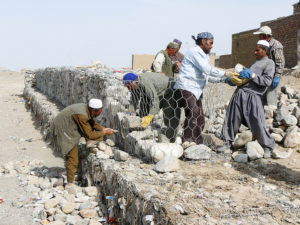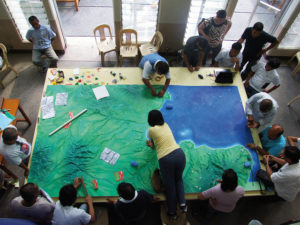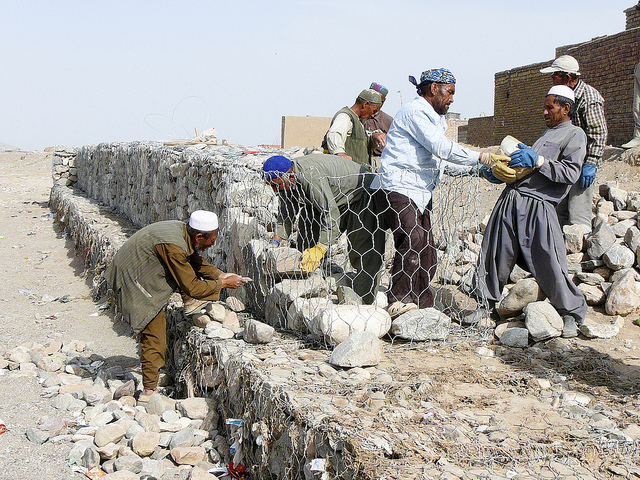Disaster Risk Reduction & Disaster Risk Management
The policy objective of anticipating and reducing risk is called disaster risk reduction (DRR). Although often used interchangeably with DRR, disaster risk management (DRM) can be thought of as the implementation of DRR, since it describes the actions that aim to achieve the objective of reducing risk.
Disaster risk is an indicator of poor development, so reducing disaster risk requires integrating DRR policy and DRM practice into sustainable development goals.
What is disaster risk reduction?
Historically, dealing with disasters focused on emergency response, but towards the end of the 20th century it was increasingly recognised that disasters are not natural (even if the associated hazard is) and that it is only by reducing and managing conditions of hazard, exposure and vulnerability that we

© UNOPS CC BY-NC-ND 2.0
can prevent losses and alleviate the impacts of disasters. Since we cannot reduce the severity of natural hazards, the main opportunity for reducing risk lies in reducing vulnerability and exposure. Reducing these two components of risk requires identifying and reducing the underlying drivers of risk, which are particularly related to poor economic and urban development choices and practice, degradation of the environment, poverty and inequality and climate change, which create and exacerbate conditions of hazard, exposure and vulnerability. Addressing these underlying risk drivers will reduce disaster risk, lessen the impacts of climate change and, consequently, maintain the sustainability of development (UNISDR, 2015a).
We need to manage risks, not just disasters.
DRR is a part of sustainable development, so it must involve every part of society, government, non-governmental organizations and the professional and private sector. It therefore requires a people-centred and multi-sector approach, building resilience to multiple, cascading and interacting hazards and creating a culture of prevention and resilience. Consequently DRM includes strategies designed to:
- avoid the construction of new risks
- address pre-existing risks
- share and spread risk to prevent disaster losses being absorbed by other development outcomes and creating additional poverty
Although DRM includes disaster preparedness and response activities, it is about much more than managing disasters (UNISDR, 2015a).
Successful DRR results from the combination of top-down, institutional changes and strategies, with bottom-up, local and community-based approaches. DRM programmes should not be standalone but instead be integrated within development planning and practice, since disasters are an indicator of failed or skewed development, of unsustainable economic and social processes, and of ill-adapted societies (UNISDR, 2009b, 2011, 2013 and 2015a). Approaches need to address the different layers of risk (from intensive to extensive risk), underlying risk drivers, as well as be tailored to local contexts. There is no ‘one-size fits all’ approach to DRM, but there exist a number of approaches and frameworks, which have been effectively implemented to reduce disaster risk. But, before being able to reduce risk, we need to understand the hazards, and the exposure and vulnerability of people and assets to those hazards.
How do we reduce risk?
Disaster risk management involves activities related to:
PreventionActivities and measures to avoid existing and new disaster risks (often less costly than disaster relief and response). For instance, relocating exposed people and assets away from a hazard area. |
TransferThe process of formally or informally shifting the financial consequences of particular risks from one party to another whereby a household, community, enterprise or state authority will obtain resources from the other party after a disaster occurs, in exchange for ongoing or compensatory social or financial benefits provided to that other party. For instance, insurance. |
MitigationThe lessening or limitation of the adverse impacts of hazards and related disasters. For instance, constructing flood defences, planting trees to stabilize slopes and implementing strict land use and building construction codes. |
PreparednessThe knowledge and capacities of governments, professional response and recovery organisations, communities and individuals to effectively anticipate, respond to, and recover from the impacts of likely, imminent or current hazard events or conditions. For instance, installing early warning systems, identifying evacuation routes and preparing emergency supplies. Source of text: UNISDR (2017) |
Implementation of these activities and measures is rarely done in isolation and includes a number of associated activities, including:
- Identification and measuring disaster risk
- Education and knowledge development
- Informing people about their risk (awareness raising)
- Incorporating DRM into national planning and investment
- Strengthening institutional and legislative arrangements
- Providing financial protection for people and businesses at risk (finance and contingency planning)
- Integrating DRR across multiple sectors, including health, environment, etc.
Activities for reducing risk can be described as structural, for instance land use planning and implementation of building codes, and non-structural, for instance awareness raising, policy-making and legislation. How governments, civil society and other actors organise DRM, for example through institutional arrangements, legislation and decentralisation, and mechanisms for participation and accountability is termed risk governance (UNISDR, 2011). There is clear evidence to suggest that low-income countries with weak governance are more vulnerable and less resilient to disaster risk (UNISDR, 2013, 2015a).
Fundamentally, DRR succeeds in reducing risk by building the strengths, attributes and resources available within a community, society or organization – collectively known as their capacity. DRM activities are designed to increase the resilience of people, communities, society and systems to resist, absorb, accommodate and to recover from and improve well-being in the face of multiple hazards. Activities for reducing and managing risks can therefore provide a way for building resilience to other risks. In addition to development, DRM should therefore be integrated across a number of sectors, including climate change and conflict.
Identifying and understanding risk: the foundation of risk reduction
Awareness, identification, understanding and measurement of disaster risks are all clearly fundamental underpinnings of disaster risk management (UNISDR, 2015b). Disaster risk reduction is about decisions and choices, including a lack of, so risk information has a role in five key areas of decision making:
Risk identificationBecause the damages and losses caused by historical disasters are often not widely known, and because the potential damages and losses that could arise from future disasters (including infrequent but high-impact events) may not be known at all, DRM is given a low priority. Appropriate communication of robust risk information at the right time can raise awareness and trigger action. |
Financial protectionDisaster risk analysis was born out of the financial and insurance sector’s need to quantify the risk of comparatively rare high-impact natural hazard events. As governments increasingly seek to manage their sovereign financial risk or support programs that manage individual financial risks (e.g., micro-insurance or household earthquake insurance). |
Risk reductionHazard and risk information may be used to inform a broad range of activities to reduce risk, from improving building codes and designing risk reduction measures (such as flood and storm surge protection), to carrying out macro-level assessments of the risks to different types of buildings (for prioritizing investment in reconstruction and retrofitting, for example). |
Resilient reconstructionRisk assessment can play a critical role in impact modelling before an event strikes (in the days leading up to a cyclone, for example), or it can provide initial and rapid estimates of human, physical, and economic loss in an event’s immediate aftermath. Moreover, risk information for resilient reconstruction needs to be available before an event occurs, since after the event there is rarely time to collect the information needed to inform resilient design and land-use plans. |
PreparednessAn understanding of the geographic area affected, along with the intensity and frequency of different hazard events, is critical for planning evacuation routes, creating shelters, and running preparedness drills. Providing a measure of the impact of different hazard events—potential number of damaged buildings, fatalities and injuries, secondary hazards—makes it possible to establish detailed and realistic plans for better response to disasters, which can ultimately reduce the severity of adverse natural events. Source: adapted from GFDRR (2014a) |

If those exposed to hazards are unaware of the risks they face, it is difficult to see how or why households, businesses or governments would invest in reducing their risk levels. However, while risk awareness may be a precondition, the importance people attach to managing their risks can only be understood in the context of the full range of social, economic, territorial and environmental constraints and opportunities they face (UNISDR, 2015a) – see the story of Ratnapura and the Chao Phraya River below.
We have over 30 years of research into disaster risk, but much of this is not available in a form that is understandable or useful to those who need it the most. There is therefore a need for risk scientists and researchers to shift their focus to the production of risk information that is understandable and actionable for different kinds of users: in other words, risk knowledge (CDKN, 2014; GFDRR, 2014a in UNISDR, 2015a,b). Such a shift requires more collaboration and partnerships between scientists and researchers and those involved in DRR, ranging from governments to local communities.
Governments need to invest in the collection, management and dissemination of risk information, including disaster loss and impact statistics, hazard models, exposure databases and vulnerability information. At the same time, they need to put standards and mechanisms in place to ensure openness and transparency so that users not only have access to the information they need but are aware of its underlying assumptions and limitations (UNISDR, 2015a). The generation of understandable and actionable risk information needs to be particularly sensitive to extensive risk, which, because it is configured to a large extent by social, economic and environmental vulnerability, can be reduced effectively through risk management and sustainable development practices (UNISDR, 2015b).
